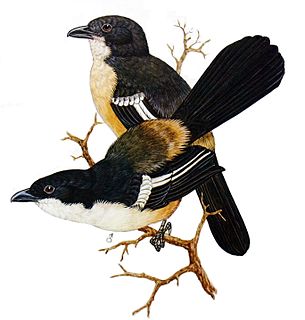
The International Union for Conservation of Nature (IUCN) Red List of Threatened Species, founded in 1964, is the world's most comprehensive inventory of the global conservation status of biological species. It uses a set of precise criteria to evaluate the extinction risk of thousands of species and subspecies. These criteria are relevant to all species and all regions of the world. With its strong scientific base, the IUCN Red List is recognized as the most authoritative guide to the status of biological diversity. A series of Regional Red Lists are produced by countries or organizations, which assess the risk of extinction to species within a political management unit.
The link rat is a species of rodent in the family Muridae. It is also known by the common name Congo forest mouse. It is native to central Africa.

A least-concern species is a species that has been categorized by the International Union for Conservation of Nature (IUCN) as evaluated as not being a focus of species conservation because the specific species is still plentiful in the wild. They do not qualify as threatened, near threatened, or conservation dependent.

The broad-eared bat or broad-tailed bat is a species of free-tailed bat from the Americas.
The Rio de Janeiro arboreal rat is a rodent species from South America. It is found in Brazil. It is the only species in the genus Phaenomys.

The rusty pitohui is a species of bird in the family Pachycephalidae. It is found throughout the lowlands of the Aru Islands and New Guinea.

The southern boubou is a bushshrike. Though these passerine birds and their relations were once included with true shrikes in the Laniidae, they are not closely related to that family.

The austral parakeet, austral conure, or emerald parakeet is a parrot found from the southern tip of South America – further south than any other parrot – to as far north as Temuco. It is a fairly large conure, 35 cm. It is primarily green, lightly barred, with some dull red on the forehead and lores, belly, and upper tail, with the northern part of the range displaying less red.

A species that is extinct in the wild (EW) is one that has been categorized by the International Union for Conservation of Nature as known only by living members kept in captivity or as a naturalized population outside its historic range due to massive habitat loss.
Orthosiphon ferrugineus is a species of flowering plant in the family Lamiaceae. It is found only on Socotra Island, part of the nation of Yemen. Its natural habitat is subtropical or tropical dry shrubland.
Hyperolius ferrugineus is a species of frog in the family Hyperoliidae. It is endemic to Democratic Republic of the Congo. Its natural habitats are subtropical or tropical moist lowland forests, swamps, freshwater marshes, and intermittent freshwater marshes.

The Cocos cuckoo is a species of cuckoo in the family Cuculidae. It is endemic to Cocos Island, an island in the Pacific Ocean which is part of Costa Rica.

The ferruginous-backed antbird is a species of passerine bird in the family Thamnophilidae. It inhabits the Guyanas and the northern Amazon Basin. Its natural habitat is subtropical or tropical moist lowland forests.
Deronectes ferrugineus is a species of beetle in family Dytiscidae. It is endemic to Portugal.

Tramea is a genus of dragonflies in the family Libellulidae, the skimmers and perchers. Species of Tramea are found in tropical and subtropical regions around the globe. They typically have colored bases to their otherwise translucent hindwings. In particular when they fly, this creates the impression of their carrying bags at the start of their abdomens. They are known commonly as saddlebags or saddlebags gliders.

The rusty parrotfish is a species of marine ray-finned fish, a parrotfish belonging to the family Scaridae. It is associated with reefs in the north western Indian Ocean and the Red Sea.

The World's 25 Most Endangered Primates is a list of highly endangered primate species selected and published by the International Union for Conservation of Nature (IUCN) Species Survival Commission (SSC) Primate Specialist Group (PSG), the International Primatological Society (IPS), Global Wildlife Conservation (GWC), and Bristol Zoological Society (BZS). The IUCN/SSC PSG worked with Conservation International (CI) to start the list in 2000, but in 2002, during the 19th Congress of the International Primatological Society, primatologists reviewed and debated the list, resulting in the 2002–2004 revision and the endorsement of the IPS. The publication was a joint project between the three conservation organizations until the 2012–2014 list when BZS was added as a publisher. The 2018–2020 list was the first time Conservation International was not among the publishers, replaced instead by GWC. The list has been revised every two years following the biannual Congress of the IPS. Starting with the 2004–2006 report, the title changed to "Primates in Peril: The World's 25 Most Endangered Primates". That same year, the list began to provide information about each species, including their conservation status and the threats they face in the wild. The species text is written in collaboration with experts from the field, with 60 people contributing to the 2006–2008 report and 85 people contributing to the 2008–2010 report. The 2004–2006 and 2006–2008 reports were published in the IUCN/SSC PSG journal Primate Conservation,, since then they have been published as independent publications.












